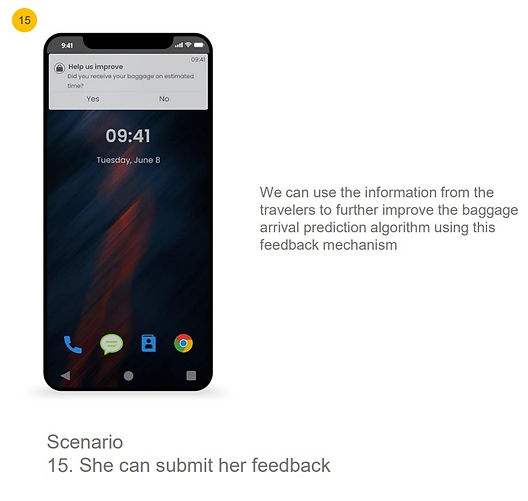
Domain- Aviation
Case Study:
A traveler has landed at New Delhi International Airport and needs to find her checked bag. Create a low-fidelity interaction flow that helps the traveller find her bag from her mobile app.
Process:
There are several models that systematize the design thinking process. I preferred going with the following model for this particular task
DISCOVER
DEFINE
IDEATE
PROTOTYPE
Pre Research
Challenges
Goal
Research
User Interview
User Persona
User Journey Map
POV(Point of View)
How Might We
Brainstorming
Wireframe
Final UI screens
Discover
Pre Research:
Key highlights of the research report from 2020 IT Passenger Insights from a survey conducted by SITA Aero.
Survey was conducted in
Q1- 2020
Online Survey
6813 respondents
27 Countries
Recent Travellers
Source: SITA Aero 2020 IT Passengers Insights
Key Insights:
1. Technology adoption fluctuates widely across journey stages.
2. Mobile is becoming the norm across airport Touchpoints.
3. Digital identity management is considered a key future technology.
4. Technology users confirmed higher satisfaction rate along the journey.
5. Information sharing at bag collection can be improved.

1.24% – similar to in 2019 – say they received information via their mobile device.
2.Type of information received, 59% were being told belt numbers and 42% were being told time until delivery.
3.The average number of bags carried by passengers has increased, reaching an average of 1.38 bags per passenger in 2019 – representing 14% increase from previous year
Challenges:
1.Rely on desk research.
2.Research on bag tracking technology used.
3.Explore reliable options with existing technology.
4.Decide whether to design a mobile app for a specific airline/ airport or an app with bag tags
Before defining the goal and to know more about the user issues.

Goal redefined:
It can be a time consuming and annoying experience for travelers to find their luggage when they arrive at their destination. Aim is to create a transparent experience so that users can always track their baggage on real time and easily find it.
Research:
Some of my key research on baggage tag technology -
RFID Tags
1.Longer to standardize
2.High cost & maintenance.
Bar Codes
1.Minimum investment compared to RFID.
2.Readily available on boarding pass and baggage tags.
3.No additional investment required.
Baggage tracking data is available with respective airline authorities.
Baggage tracking data needs to be shared with the respective users to enhance their experience in finding bag.
Constraints
1.Since the baggage tracking data is already available with the respective airline, I am assuming Bar code technology is used at Delhi airport for this task.
2.My stake holders are travelers, Airline and Airport infrastructure.
Being a silent airport in India, there is no announcement made
User Interview
To interview and explore the pain points of the user, I identified my target users first based on following criteria
First time travellers
Experienced Travellers
Aged Travellers
Travelling with Family
Airline Staff
Tourists
New traveler
Age group (18+)
Frequent traveler
Professional etc
Age group (18+)
Travelers who may need assistance
Age group (60+)
Travelers traveling in a group
Ground staff Airport authority
Telephonic discussion with 4 users for approximately 8-12 minutes each. Questions based on-
How do you feel when you visit Delhi airport?
Can you tell me about your first visit to that airport?
How do you compare your experience of last visit to the first visit?
How did you find your baggage claim?
What were the challenges you faced?
Some pain points of the users include:
1.Waiting for the luggage at conveyor belt and feels annoyed.
2.First time traveler - No announcements are being made.
3.Aged traveler – Was worried as we couldn’t locate the baggage claim initially.
4.A staff from private airline in India, 6-7 times in a month there are passengers who pick the wrong baggage. Often these include old passengers, ones with infants or those in a hurry to leave
Define
Personas

Empathy Mapping

User Journey Mapping


Ideate
Point of view = User's + Needs + Insights
Keeping user needs and Insights POV statement allows to generate possible solutions in a goal-oriented manner followed by HMW to kick start ideation process.

Brainstorming Solutions:
Pain points at earlier stage:
1.Waiting for baggage
2.No announcements
3.Unable to locate baggage claim
Additional Pain points discovered:
1. Picking up wrong baggage.
2. Crowded near the bag conveyors.

Prototype
Assumptions:(for this case study)
1. Main focus is on the application after passengers have landed at an airport and notification is opened on an app browser.
2. Barcode/QR code for the check in baggage is available for the user to scan before baggage.
3. There are three ways in which the application can get the baggage information.
a) The user manually scans the barcode in his boarding pass.
b) The airline updates the information within app itself.
c) The airline sends the baggage information in the form of a notification or an email, which is read by the app/ browser and updated accordingly.
4. Airline releases the baggage status details to the users in 3 stages
a) Loading into airplane,
b) Unloading from airplane
c) Loading into baggage carousal
There could be an additional 360 degree scanner installed at the entrance of the baggage belt at the arrival area for ETA.
5. Destination gets set to baggage claim area to help users navigate easily.
6. Airports can have a way to identify the bar code on boarding pass with baggage tag. This will be useful to avoid picking up wrong baggage.






Key Highlights: (Benifits)
1. Airports can collaborate with third parties if required to enhance the baggage claim experience of passengers at airport. For example, to install barcode scanner at the critical points.
2. It will cost very low to Airports and airlines and is easily scalable without passengers having to buy advanced baggage.
3. Maximum ROI for airlines with minimum investment. Baggage data is already available with the airlines, which they simply need to release to the passengers on demand. It reduces baggage related anxiety and the expenditures on lost or missing baggage